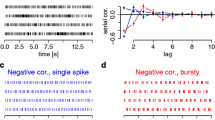Abstract
We present a procedure to detect recurring discharge patterns in multiple spike trains. Such recurring patterns can include many spikes and involve from three to many spike trains. The pattern detection procedure is based on calculating the exact probability of randomly obtaining each individually recurring pattern. The statistical evaluation is based on the use of 2 × 2 contingency tables and the application of Fisher's exact test. Several simulations are applied to evaluate the method. Findings based on applying the procedure to simultaneously recorded spike and event trains are described in a companion paper (Frostig et al. 1990).
Similar content being viewed by others
References
Abeles M (1983) The quantification and graphic display of correlation among three spike trains. IEEE Trans Biomed Eng 30:235–239
Abeles M, Gerstein GL (1988) Detecting saptiotemporal firing patterns among simultaneously recorded single neurons. J Neurophysiol 60:909–924
Abeles M, de Ribaupierre F, de Ribaupierre Y (1983) Detection of single unit responses which are loosely time-locked to a stimulus. IEEE Trans SMC-13-683-691
Dayhoff JE, Gerstein GL (1983a) Favored patterns in spike trains. I. Detection. J Neurophysiol 49:1334–1348
Dayhoff JE, Gerstein GL (1983b) Favored patterns in spike trains. II. Application J Neurophysiol 49:1349–1363
Epping W, van den Boogaard H, Aertsen A, Eggermont J, Johannesma P (1984) The neurochrome: an identity preserving representation of activity patterns from neural populations. Biol Cybern 50:235–240
Frostig RD, Frostig Z, Harper RM (1984) Information trains. The technique and its uses in spike train and network analysis, with examples taken from the nucleus parabrachialis medialis during sleep-waking states. Brain Res 322:67–74
Frostig RD, Frysinger RC, Harper RM (1990) Recurring discharge patterns in multiple spike trains. II. Application in forebrain areas related to cardiac and respiratory control during different sleep-waking states. Biol Cybern 62:495–502
Gerstein GL, Perkel DH, Subramanian KN (1978) Identification of functionally related neural assemblies. Brain Res 140:43–62
Hayes WL (1981) Statistics, (3rd edn.). Holtz Rinehart and Winston, San Francisco
Klemm WR, Sherry CJ (1982) Do neurons process information by relative intervals in spike trains? Neurosci Biobehav Rev 6:429–437
Legendy CR, Salcman M (1985) Bursts and recurrences of bursts in the spike trains of spontaneously active striate cortex neurons. J Neurophysiol 53:926–939
Levine MW (1980) Firing rates of a retinal neuron are not predictable from interspike interval statistics. Biophys J 30:9–25
Perkel DH, Gerstein GL, Moore GP (1967) Neuronal spike trains and stochastic point processes. II. Simultaneous spike trains. Biophys J 7:419–440
Perkel DH, Gerstein GL, Smith MS, Tatton WG (1975) Nerve-impulse patterns: a quantitative display technique for three neurons. Brain Res 100:271–296
Yamamoto M, Nakahama H (1983) Stochastic properties of spontaneous unit discharges in somatosensory cortex and mesencephalic reticular formation during sleep-walking states. J Neurophysiol 49:1182–1198
Author information
Authors and Affiliations
Rights and permissions
About this article
Cite this article
Frostig, R.D., Frostig, Z. & Harper, R.M. Recurring discharge patterns in multiple spike trains. Biol. Cybern. 62, 487–493 (1990). https://doi.org/10.1007/BF00205110
Received:
Accepted:
Issue Date:
DOI: https://doi.org/10.1007/BF00205110




